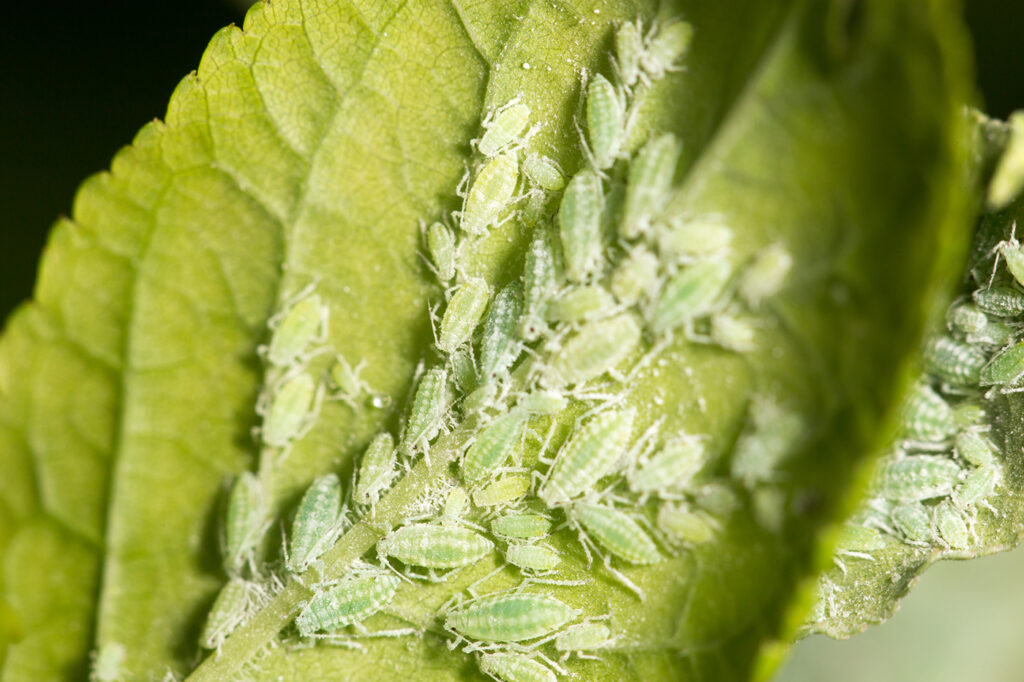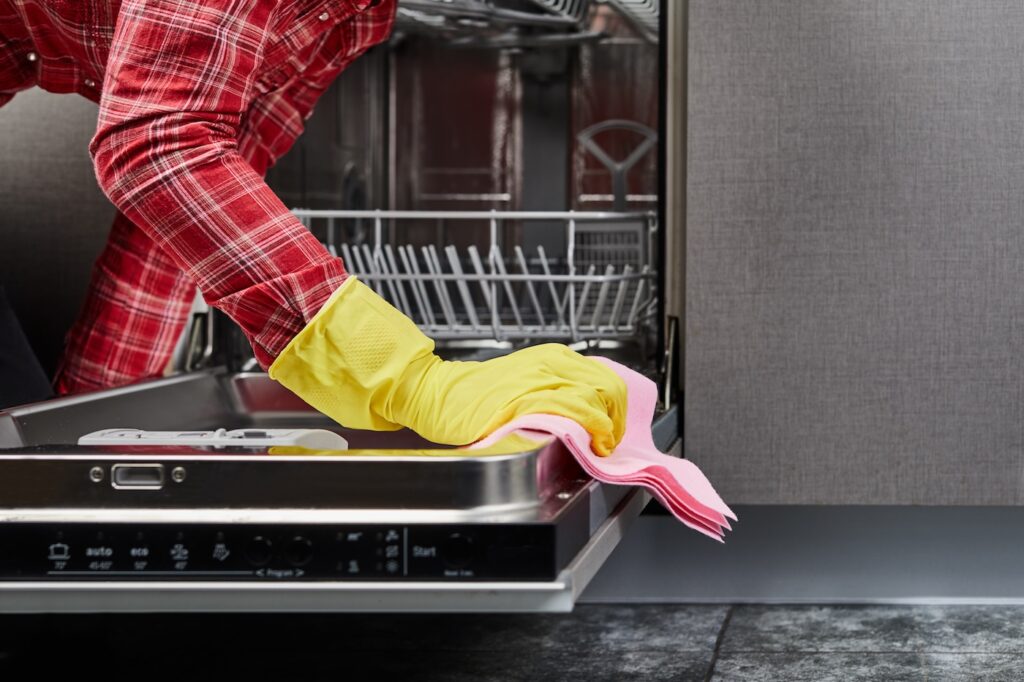Aphids are tiny, soft-bodied insects that can quickly become a nuisance for houseplant enthusiasts. These unwelcome guests suck the sap out of your plants, weakening them and stunting their growth. Aphids on houseplants are not something you want—a mild infestation might not seem like a big deal, but if left unchecked without aphids treatment, the bug population can explode, causing significant damage to your indoor plants.
You might now be wondering how to get rid of aphids on houseplants—definitely something you should be wondering if you have no idea how to get rid of aphids permanently (or how to prevent aphids in the first place)! While aphid control is very important, it’s also essential to take action as soon as you spot them. This guide will give you all the knowledge you need to effectively remove aphids from your houseplants and prevent future infestations.
What To Know About Aphids

You might be wondering, “What do aphids look like?” While it’s essential to know how to prevent aphids and how to get rid of aphids on houseplants once you have them, you should first arm yourself with general knowledge about them.
As mentioned above, aphids are soft-bodied insects. They’re pear-shaped and come in various colors, including green, yellow, brown, and black. They have long antennae and two tube-like structures protruding from their backside. Their lifecycle is relatively short, allowing them to reproduce quickly and establish large colonies on your houseplants. Interestingly, aphids are one of the few species that can reproduce asexually or sexually. While they go through natural reproduction cycles outdoors based on season, they can reproduce even faster indoors, with fewer elements to contend with.
This is where aphid control comes into play! Now that you know the answer to the question “What do aphids look like?” you’ll easily be able to find them on the undersides of leaves, on new growth, and near stems. Since aphids feed by sucking sap from plants, effective aphid control requires targeting these areas.
Aphid Damage Symptoms

Aphid infestations can cause a variety of problems for your houseplants. Here are some of the telltale signs to watch out for:
- Curling or distorted leaves: Aphids feed by sucking sap from leaves, which can cause the leaves to curl, pucker, or become distorted.
- Sticky residue: Aphids excrete a sugary substance called honeydew. This sticky residue can coat the leaves of your plants and attract other pests like ants and sooty mold. Sooty mold appears as black patches on the leaves and can hinder photosynthesis.
- Stunted growth: Aphids weaken plants by depriving them of essential nutrients. This can lead to stunted growth, wilting, and yellowing leaves.
- Presence of ants: Ants are attracted to the honeydew produced by aphids. While ants themselves don’t harm plants, their present can be an indicator of an aphid infestation.
If you notice any of these symptoms on your houseplants, it’s important to take action to control the aphid population before it gets out of hand. You can either search the internet for “aphids treatment” or read on for tips!
Tools & Materials

When learning how to get rid of aphids permanently, you’ll likely need some or all of the following tools and materials, depending on your situation.
- Spray bottle
- Scissors or pruning sheers
- Mild dish soap or insecticidal soap
- Neem oil (optional)
- Horticultural oil (optional)
- Rubbing alcohol (optional)
- Cotton swabs (optional)
- Yellow sticky traps (optional)
Remember: Always follow the instructions and safety precautions on the label of any commercial insecticide you choose to use.
How to Get Rid of Aphids on Houseplants

While it’s important to know how to prevent aphids as part of aphid control, you might find that it’s already too late, and you have an infestation. Below are some effective methods to remove aphids from your houseplants.
1. Remove Aphids From Plant

The first step in aphids treatment is to physically remove as many aphids as possible from your plant. You can do this by:
- Blast them with water: Use a spray bottle willed with forceful jets of water to dislodge the aphids from your plants. Focus on the undersides of the leaves, stems, and areas with visible aphid clusters. Be careful not to damage your plants’ leaves, especially if they’re delicate.
- Prune the heavily infested parts: If certain parts of your plant are heavily infested, you may need to prune them off completely. This will help to reduce the aphid population and prevent them from spreading to other parts of the plant.
- Squish them with your fingers: This may not be the most pleasant option, but it’s an effective way to remove a small number of aphids.
- Use a cotton swab dipped in rubbing alcohol: Dab the cotton swab on individual aphids to kill them on contact.
2. Apply Insecticidal Soap

Insecticidal soap is a natural and effective way to control aphids on houseplants. It works by smothering the aphids and disrupting their cell membranes. Here’s how to use it.
- Mix a solution of insecticidal soap according to the manufacturer’s instructions.
- Thoroughly coat the entire plant, including the undersides of leaves, with the insecticidal soap solution.
- Let the solution sit on the plant for the recommended amount of time, then rinse the plant thoroughly with clean water.
- Repeat the application every few days until the aphid infestation is under control.
3. Apply Neem Oil

Neem oil is a natural oil extracted from the neem tree that has pesticidal and fungicidal properties. When used correctly, neem oil can be an effective way to control aphids and other houseplant pests.
- Mix a solution of neem oil and water, according to the manufacturer’s instructions. Neem oil can have a strong odor, so it’s best to use it in a well-ventilated area.
- Thoroughly coat the entire plant, including the undersides of leaves, with the neem oil solution.
- Let the solution sit on the plant for the recommended amount of time, then rinse the plant thoroughly with clean water.
- Repeat the application every few days until the aphid infestation is under control.
4. Other Treatment Options

In addition to the methods mentioned above, there are a few other options for treating aphid infestations:
- Horticulture oil spray: These oils work by suffocating the aphids.
- Pyrethrin-based insecticides: These are short-lived botanical insecticides that can be effective against aphids.
- Beneficial insects: Introducing natural predators like ladybugs or lacewings to your houseplants can help control aphid populations. These beneficial insects feed on aphids and can help to keep them in check.
5. Homemade Insecticidal Spray

For a natural and readily available option that doesn’t use pesticides, you can create a homemade insecticidal spray using readily available household items. Here’s what you’ll need:
- Spray
- Water
- Dish soap (mild, with no degreasers)
Once you have these items, do the following:
- Mix a solution of one tablespoon of mild soap with one quart of lukewarm water in your spray bottle.
- Shake the solution well to ensure the soap is evenly distributed.
- Thoroughly coat the entire plant, including the undersides of leaves, with the homemade insecticidal soap solution.
- Let the solution sit on the plant for 15-20 minutes.
- Rinse the plant thoroughly with clean water to remove the soap residue.
Remember: While dish soap can be effective in killing aphids on contact, it can also sometimes damage certain infested plants. Always research what plant you have and whether dish soap will damage it. Then test the solution on a small, inconspicuous area before applying it to the rest of the plant.
How To Prevent Aphids on Houseplants

While battling an existing aphid infestation is important, preventing them from taking over in the first place is your ideal choice for systemic aphid control. Here are some strategies to help keep your houseplants healthy and aphid-free:
- Inspect your plants regularly: When you’re needing to know how to prevent aphids, the first step is to regularly check your houseplants for signs of them, especially when bringing new plants into your home.
- Keep your plants healthy: Healthy plants are more resistant to pests like aphids. Ensure your plants are receiving the proper amount of light, water, and fertilizer.
- Quarantine new plants: Before introducing new plants to your existing collection, quarantine them for a week or two to monitor for any potential garden pests.
- Use yellow sticky traps: Yellow sticky traps can help attract and trap aphids before they have a chance to establish themselves on your affected plants. Place the traps near your houseplants but not directly touching them. The sticky substance will catch the aphids.
- Encourage natural predators: Ladybugs, lacewings, and parasitic wasps are natural predators of aphids on outdoor plants. You can encourage these beneficial insects by planting predator-attracting flowers near your outdoor plants or purchasing ladybugs to release them nearby for a short-term solution.
If you follow the above steps, you may never need to know how to get rid of aphids permanently, because you won’t have infestations on your plants!
Hire a Gardening Tasker to Help With Aphid Infestation
Aphids can be a nuisance for houseplant enthusiasts, but with the right knowledge and techniques, you can effectively control and prevent infestations. If you’re short on time or gardening skills, however, Taskrabbit can connect you with skilled Taskers who can help with all types of gardening tasks, including aphid control. Whether you need help identifying the pest, applying a treatment, repotting your plants, or even mounting a plant, Taskers can help you get the job done quickly and effectively. Hire a Tasker today!














